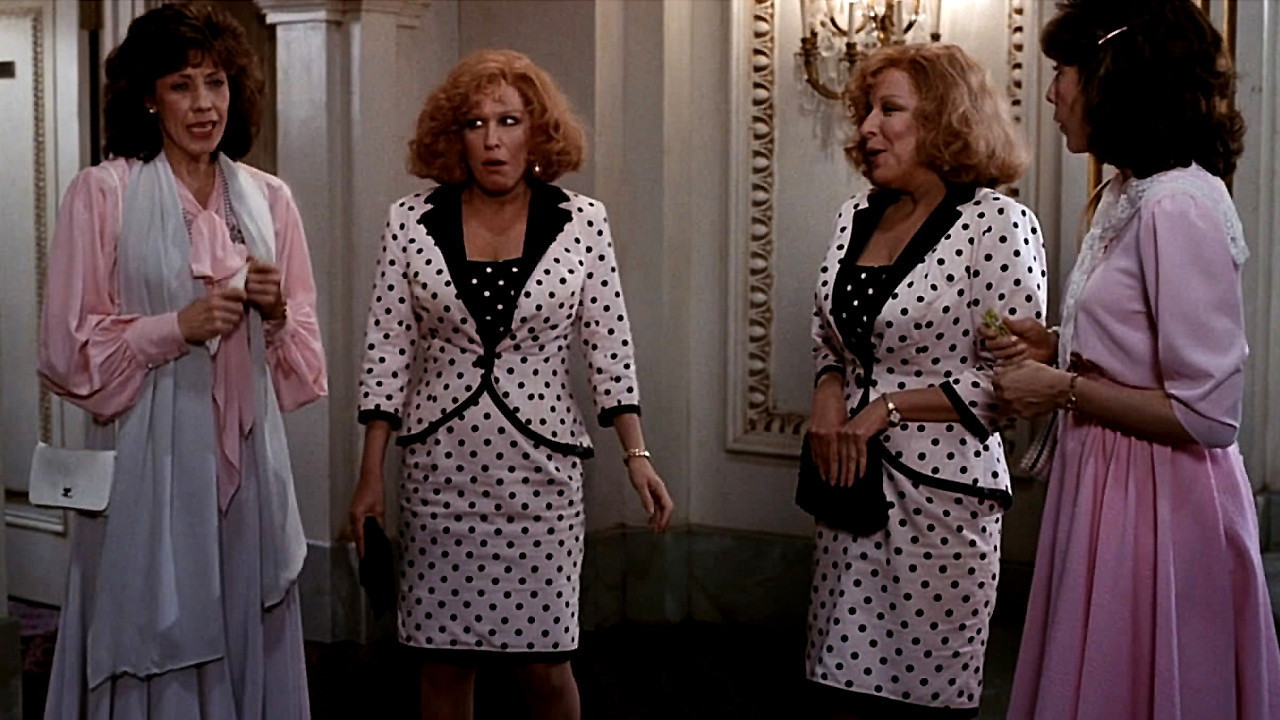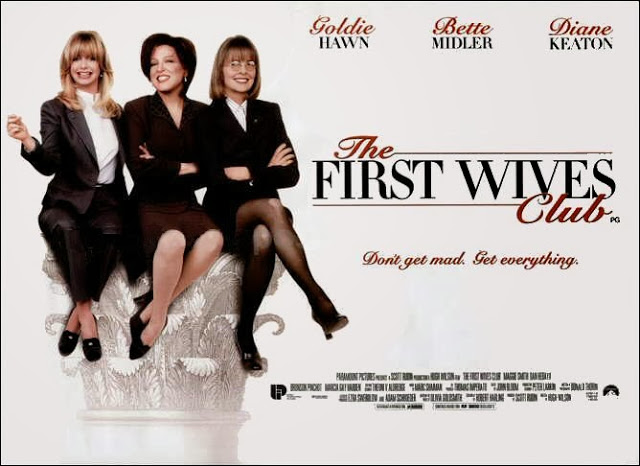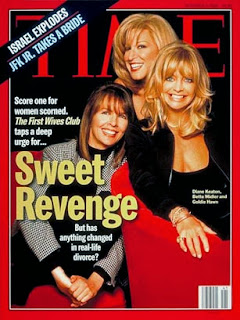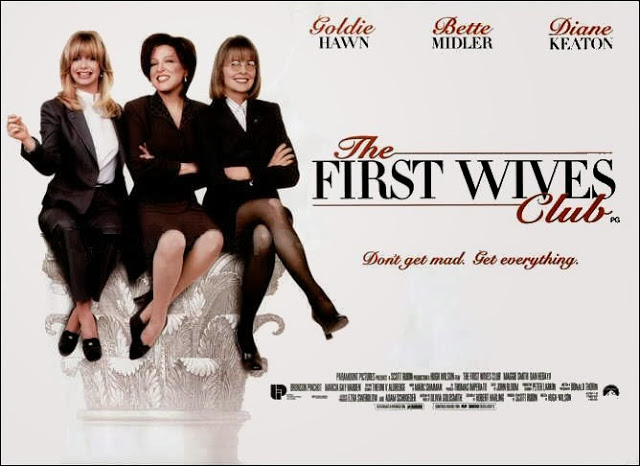This guest post written by Kyle Sanders appears as part of our theme week on Ladies of the 1980s.
When you combine the talents of Bette Midler and Lily Tomlin, you wind up with three Academy Award nominations, four Grammy awards, three Tony awards, and ten Emmy awards — not too shabby for two women in show business. Both have shined so brightly in their respective fields, that it was only a matter of time before the two starred together in a film, which ultimately became 1988’s Big Business. Loosely based on Mark Twain’s The Prince and the Pauper and William Shakespeare’s Comedy of Errors, the film stars Midler and Tomlin as two sets of twins mismatched at birth, who eventually reunite over the fate of a small town. The film was a modest box office success at the time, but decades later, their comedic chemistry still remains intact, and stands as a testament to successful female-driven comedies.
Big Business begins with the coincidental timing of two births: one from a wealthy couple traveling through Jupiter Hollow (an Appalachian town in West Virginia) and the other from a family of impoverished locals. Both women give birth to identical twin girls. In a hilarious mishap, both sets of twins get mixed up thanks to the confused nurse. Nearly forty years later, wealthy “twins” Sadie (Midler) and Rose (Tomlin) Shelton are co-chairwomen of Moremax — the successor to their father’s business located in New York City — and ultimately want to sell Hollowmade, a furniture factory located in the very town where they were born. Naturally, there is some resistance from Jupiter Hollow’s townsfolk, led by the factory’s forewoman, Rose Ratliff (Tomlin, again), who plans to travel to New York and protest with her “twin sister” Sadie (Midler, again) to “raise some heck” and “kick some snooty New York ass.” As luck would have it, both sets of twins end up staying at the Plaza Hotel, causing much comical confusion and physical hijinks amongst the women’s suitors and hotel employees. It’s not until the end of the film that all four women become acquainted, recognizing their familial bond and end up saving the rural town from being completely strip mined.
This film came out in the summer of 1988, so of course, there are some choice fashionable references of the era — shoulder pads, stark white Reebok sneakers, polka dots — but also gnarly pop cultural references of the 80s as well. Sadie Ratliff is mesmerized by an episode of Dynasty, a Times Square marquee features Disorderlies and Monster Squad (both films from 1987), and a totally bogus movie ending features Steve Winwood’s “Higher Love” playing over the credits (hey, it was the 80s!). Yet what sets this 80s flick apart from most films of that era is the fact that the four protagonists are all women AND completely independent.
Sure, it’s clear that Midler’s Sadie Shelton had once married and had a child, but has chosen business over family, maintaining heavy control over her father’s corporation instead of devoting attention on her out of control son (played by a young Seth Green). Although Tomlin’s Rose Ratliff has a boyfriend who expects her to cheer him on at his miniature golf tournament (tubular!), she chooses to save her town’s way of life over standing at her man’s side. These women are ambitious and too focused on their professional futures to be restrained by traditional standards. The film makes it clear that these women are forces to be reckoned with.
Let us not forget the other sisters either. Rose Shelton may not be as hard edged or ruthless as her sister Sadie, but she too remains independent. She feels out of place in the corporate world, struggling to maintain even a flimsy shoulder pad slipping down her sleeve (a metaphorical rejection of the big business lifestyle, perhaps?). She’d rather exchange it all for a simpler existence involving “a goat and some ducks.” Meanwhile, Sadie Ratliff feels stuck in the sticks and dreams of a totally glamorous, upscale lifestyle. As she reenacts a scene from Dynasty (involving bitchin’ iconic businesswoman Alexis Carrington, no less), it’s clear how much she’s yearned for a dazzling position in power, of which her rural upbringing has very few resources to offer.
These diverse options provide a radically different perspective of living compared to the mothers that birthed them in the 1940s: Mrs. Shelton’s pregnancy was more of a negotiation in exchange for an extended wardrobe and jewelry, while Mrs. Ratliff’s pregnancy seems to be business as usual, commenting on what’s changed in the delivery room since “the last time” she was there. In a way, the film specifically opens during that time to suggest how women have evolved in the “modern era” of the late 80s.
And who better to portray the modern woman? The four varied, fully dimensional characters in Big Business could only be compellingly and hilariously portrayed by Midler and Tomlin. Between Midler’s big-eyed glares and Tomlin’s dizzying hysterics, both actresses’ comedic physicality provide specific mannerisms to each version of Sadie and Rose that when all four do share the same screen (thanks to some bogusly dated 80s special effects), it’s easy to distinguish these characters.
As different as each woman is, they all share one thing in common: respect amongst their peers. The Shelton sisters are president and senior vice president of Moremax, surrounded by men who await their professional decisions. While Rose is the “wispy” sister, Sadie holds court at Moremax. Sadie’s grand introduction (in a setup that clearly inspired Miranda Priestly’s entrance in The Devil Wears Prada) has her entire staff racing around the office to prepare for her appearance, and within seconds upon arriving she’s already ripping into her employees, be it with their choice of attire or failure of completing tasks. Her cold composure and piercing stare are intimidating; she is never intimidated or buckles to corporate pressure. It’s surprising then that not once throughout the entire film is she ever referred to as the proverbial “bitch.” Sadie is one bodacious businesswoman, and no man ever undermines her decisions.
The Ratliff sisters also are shown a great amount of respect. The entire community calls upon them to save their town from getting strip mined, which is surprising considering how rural culture is often depicted as placing women either in the kitchen or in the nursery — like their mother 40 years prior. Once Rose and Sadie Ratliff arrive in New York, completely out of their comfort zone, they quickly adapt to their surroundings. Through a string of cheesy 80s montages, Rose infiltrates the ins and outs of the Plaza Hotel, spreading word of Moremax’s devious intentions with Jupiter Hollow through various disguises (“Guten morgan!”), while Sadie explores the city, learning how to (aggressively) hail a taxi cab. The Ratliff women might be from a small town but they are not small minded.
For a film centered on strong-willed women, the weakest part of the plot comes from their interactions with men. Sadie Shelton’s ex-husband is judgmental of his wife’s monetary bribes to their spoiled son, yet instantly falls back in love with her once (unbeknownst to him) Sadie Ratliff does some quick-thinking discipline inside the toy store FAO Schwarz (??). Rose Shelton’s spineless boyfriend won’t propose marriage because he’s scared of her sister, but Rose Ratliff rebuffs his advances later on and somehow inspires him to buy a ring (??). I don’t buy it. As palpable as Sadie Shelton’s sexual power plays with Fabio Alberici (the man who plans to buy out Jupiter Hollow from Moremax) are, the deal ultimately falls through, and seems to have no consequences on their romantic chemistry. The only relationship that seems to have enough substance to continue on occurs between Rose Shelton and Roone, Rose Ratliff’s boyfriend. He sets out to New York in a quest to rescue Rose Ratliff, but instead ends up saving Rose Shelton from a life she’d rather not live. He senses the insufferableness of her situation, which in turn helps her discover her true nature, allowing her to focus and feel comfortable about herself for the first time in her life. Sure, it plays out like a grody Damsel in Distress scenario, but it ultimately makes Rose a fully realized individual by the end of the film, and it’s because of her solid plea to the stockholders to not sell out Jupiter Hollow that eventually saves the day.
Ultimately, it is Midler and Tomlin who save the film from being just another forgotten comedy of the 1980s. The two stars bring a certain gravitas to the screen — a perfect combination of comedic timing and contagious chemistry in scenes that might otherwise fall flat in the hands of other capable actresses. The material provided from the script (co-written by Dori Pierson, who unfortunately never penned another screenplay after this one), isn’t entirely fresh, yet Midler’s and Tomlin’s performances keep the comedy from going stale.
These women are no strangers to the medium, as Midler got her start gaining a following in a gay bathhouse, thanks to her vibrant showmanship and bawdy humor. Tomlin, on the other hand, is considered a female pioneer of standup, who in the 1960s presented cerebral character sketches instead of self-deprecating jokes about marriage and motherhood. Both women proved their star power throughout the 1980s, in previous female-driven comedies such as 9 to 5 (1980) and Outrageous Fortune (1987). Thanks to them, Big Business earned a solid box office return, ranking in the top 30 highest-grossing films of 1988. Their solid comedic teamwork — much like the combined efforts of all four Shelton and Ratliff sisters — saves the film from being a run-of-the-mill, haphazard case of switched identities, into a film that shows how the ladies of the 1980s are able to run businesses and conserve communities at the same time — even if it means kicking some snooty New York ass!
Kyle Sanders lives in Chicago, where he studies improv at iO whenever he can afford it. He has previously written for Bitch Flicks, as well as NewsCastic: Chicago and GIGA: Geek Magazine.



















